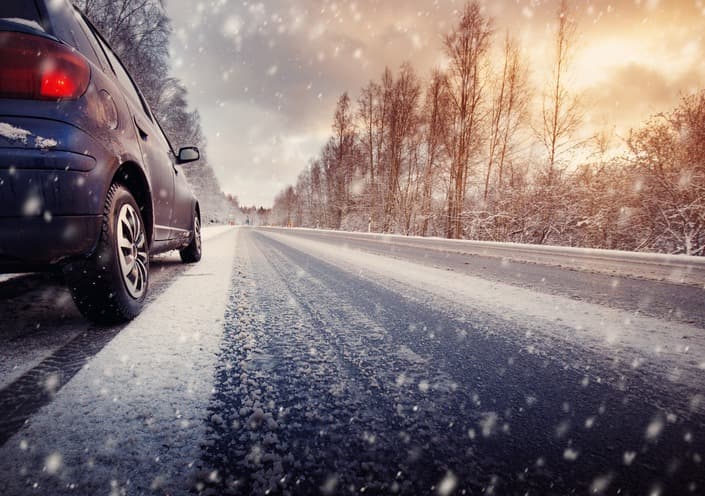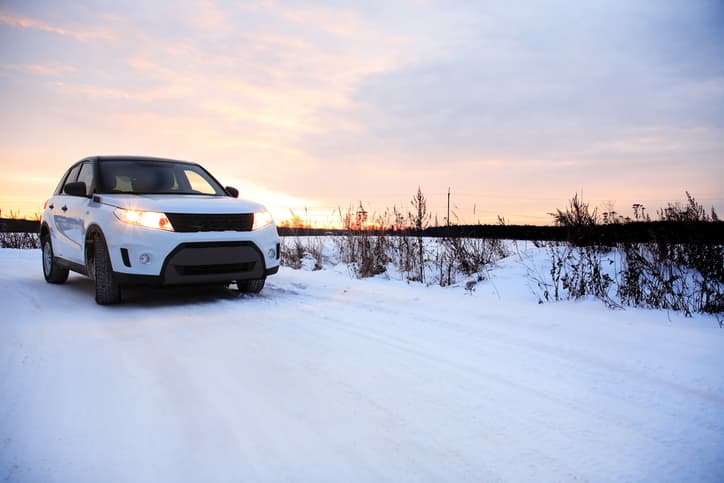Drive Safely On Ice And In Icy Conditions
Stay Safe On Icy Roads

As an island nation that’s very exposed to the open sea, Ireland experiences its fair share of cold weather. This often means high winds, icy roads and plenty of snow too, but it’s imperative that you understand how to drive safely in these kinds of conditions to keep yourself and other road users safe.
There may be some things that you can do, depending on whether you’re driving on icy roads or in snow. We’ve covered both eventualities below to help you stay safe in the cold weather.
How To Drive On Icy Roads
Ice can be treacherous for both cars and pedestrians, especially black ice that is very difficult to see. So, what’s the best way to drive on icy roads?
Check Your Tyres Regularly
Your vehicle’s tyres are the only thing that are always in contact with the road. This means, when driving in icy conditions, they’re the most important thing to check before you go anywhere. They should have enough tread to suitably grip the road and prevent sliding, and they should always be inflated to the correct pressure. Unsuitable tyres that are under or overinflated could lead to an accident.
Clear The Car Properly
Your visibility should be good at all times when you’re driving. This means you should thoroughly de-ice your car before setting off, removing any snow and ice from the vehicle, and ensure that your windscreen is fully demisted and that you can see properly. Poor visibility can lead to missed hazards that could cause an accident.
Drive Cautiously
This may seem like common sense, but you should drive more slowly when it’s icy and avoid any sudden movements, such as fast acceleration or quick braking. Manoeuvre the car cautiously, leaving more space between you and other vehicles than you might do normally to allow for extra braking time. Driving in a high gear can also sometimes help. We explain why a little further down the page.
What Should I Do If The Car Skids?
Skidding is much more likely to occur when the roads are slippery, and should this happen, it’s good to know how to control the car to avoid crashing.
One of the most important things to remember is not to touch the brakes. When you lose control of a vehicle, slamming on the brakes is likely an automatic response as you want to come to a stop. However, braking can make the slide worse and won’t correct the situation. This is because the brakes stop the wheels from moving but in order to come out of a slide, your wheels must be turning freely so they can get their grip back on the road.
So what should you do instead of pressing the brakes? You should take your feet off the pedals completely and slowly turn the steering wheel into the direction of the slide. This should be the same direction the rear of the car is turning in. You should start to feel the car straighten out, and as this happens, straighten your wheel too. Concentrate on where you want the car to go and use the wheel to make this happen.
If you turn the wheel too sharply, you may begin to skid in the opposite direction. This is quite common but don’t panic. Continue to adjust your wheel into the slide until you eventually feel the car straighten out. It’s best not to make big movements, swinging your wheel from one way to the other, as this will only make the situation worse.
Why Do You Drive In A High Gear On Ice?
It’s important to do everything you can to stay in control of the vehicle when driving on icy roads. Driving in a high gear can help you to do this, as it prevents the wheels from spinning. Use a high gear when travelling along flat roads but remember to drive in a low gear when going downhill to keep control.
How To Drive In Snow
Driving in snow is quite similar to driving in ice - you must try to drive in a high gear and go cautiously. But there are some extra things to remember too.

Always Keep Your Headlights On
Snow can affect visibility, particularly if it’s coming down thick and fast and there are no street lights around. Using dipped headlights in the snow means that other drivers can see you more easily, so make sure to turn them on even in the daytime.
Use Main Roads
Main roads are much more likely to be gritted than country or rural roads. They’re also well-lit, so where possible, use main roads to stay safe when driving in snowy conditions.
Listen To The Surface You’re Driving On
There’s almost nothing as satisfying as walking in fresh snow and hearing that ‘crunch’ under foot. You will likely be able to hear the same noise when you’re driving in snow. Listen out for it, as you may be driving on ice if you can no longer hear the crunch of the snow. This could be a sign that you need to drive even more carefully.
How To Drive Uphill In Snow
Ireland is a country full of mountainous and hilly areas. While for the majority of the year, these roads aren’t a problem, they can be harder to navigate in ice and snow. The best way to drive uphill in snow is to maintain a constant speed without accelerating or decelerating too much. Where possible, avoid using the brakes and changing gear. Instead, go slowly, keeping in the same gear until you’ve reached the top of the hill.
Is my Car Insured In The Snow?
Car insurance generally covers your vehicle for all kinds of weathers, but the general advice is to not drive in the snow as driving can be treacherous and result in a motor accident.
No matter whether you’re driving in the snow or icy conditions, it’s always a good idea to keep an extra jacket or two in the car, as well as some bottled water. Should an incident occur and you have to vacate the vehicle, you’ll be able to keep warm and hydrated while you wait for a breakdown vehicle.
